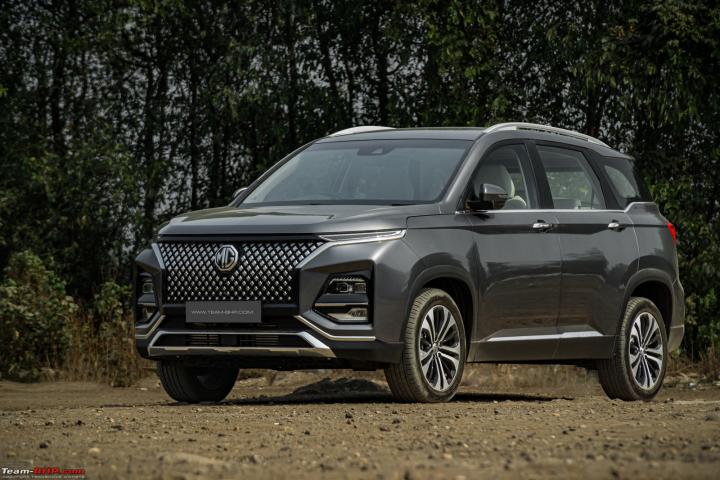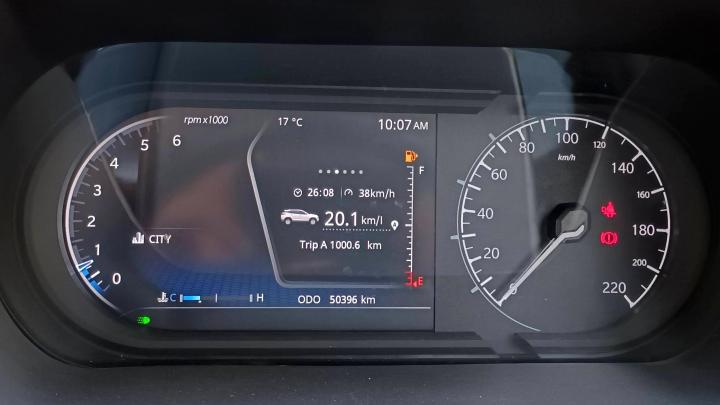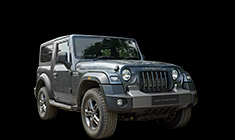News
Very happy with my Tata Harrier diesel: 8 observations after 1 month
Compared to our previous car, a Ford EcoSport running on low-profile tyres, this SUV is a marked improvement.
BHPian rahulcmoulee recently shared this with other enthusiasts.
Got the first service of my Harrier done today. Odo stands at 1033km after a month. Lots of long trips are planned in the next few months.
Following are my observations so far:
- Engine. Super strong. Having owned only naturally aspirated petrols so far, the torque of the turbo diesel is addictive. Engine pulls cleanly without much turbo lag.
- Fuel economy. Within the city, the lowest I've gotten is 10.3kpl and when the roads are empty, I have gotten as high as 14.8 kpl. Have done the Bangalore-Mysore journey twice and while cruising between 90-100 with cruise control on, I have gotten 18kpl. Overall, very satisfied with the economy for a car of this size with this much power.
- Ride and Handling. Suspension setup is slightly on the stiffer side. However, compared to our previous Ecosport running on low-profile tyres, this is a marked improvement. High-speed stability is phenomenal. Car stays rock solid at highway speeds. One can munch through the miles effortlessly. Brakes are sharp and have a decent bite too.
- Steering. A lot has been said of the Harrier's steering. Personally, I haven't felt the weight to be too much at parking speeds and it is quite easy to twirl. At highway speeds, it is a touch lighter than what I'd ideally like but nothing alarming enough to hamper your confidence.
- Infotainment. The new 10.25-inch touchscreen is a huge leap ahead over the old system. The UI is slick and the responses are fast. The cherry on the cake is the fantastic 360-degree camera. The quality is crystal clear and makes parking and manoeuvring in tight spaces much easier, which is a boon on a car this size.
- ADAS. The Harrier has level 1.5 (?) ADAS functionality. This is the perfect level for Indian roads in my opinion. It warns you about potential dangers but control of the car fully remains with you. I find the Blind spot detection and Lane departure warning particularly useful on our roads.
- Niggles. Have faced only 1 niggle so far (touch wood). Two days back, the passenger side seatbelt wouldn't buckle up. Got it checked at the service centre today and apparently there was a loose piece of plastic which had gotten into the buckle and was preventing the mechanism from working. They replaced the buckle free of cost under warranty.
- Service Experience. Got the car serviced at Kropex Koramangala. Called up 1 day in advance to book an appointment. SA Mr.Krishna was helpful and professional. Got the buckle replaced, software updated and DEF refilled. Total bill came up to INR 1050.
All in all, very happy with the vehicle so far. Looking forward to adding more miles to it. Leaving you with some pictures.



Check out BHPian comments for more insights and information.
- Tags:
- Indian
- Tata Harrier
- Tata Motors
News
Tata Harrier Kaziranga Edition: 31 observations in 1 year of ownership
My wife says that the passenger seat comfort of this SUV is nowhere close to that of the Renault Duster AWD that we had previously.
BHPian subuiyer recently shared this with other enthusiasts.
Took delivery of the Harrier Kaziranga KZA+ exactly a year ago, replacing Duster AWD as my primary vehicle. Having done two long drives recently (link) and the ODO crossing 18.5K, here are my experiences (and opinions) in no specific order. Some points are perhaps a repeat of what others have already said and the T-BHP review, nevertheless, here they are.
- The build is rugged and sturdy – metal parts, high-touch plastics, seats, buttons, etc. The ruggedness gives a sense of built to last, but let time and statistics speak. However, the build is not refined or polished - panel gaps, rough plastic edges, etc. +ve is no rattles, yet!
- Seat comfort – Okay-ish. I have done nearly a dozen 500+ KMS / 10+ hrs drives in the past three months. Only a faint hint of hip pain cropped on 3rd consecutive day of 500+ KMS drive. However, my wife’s verdict is passenger seat is nowhere as comfortable as the one in the Duster AWD previously owned. She struggles with back pain on 4-hr drives, even with breaks. Height adjustment for the passenger seat is sorely missed. Headrest angle adjustment is needed, but a good neck support pillow also helps.
- Armrest – mixed feeling. Good to have, deep cooled storage, difficult to reach charging ports. Sliding the top would have made it more usable / comfortable for drivers.
- Driving position – Earlier I believed there was only ‘one’ ideal position for me. In the past few months realized that was naïve, now my driving position depends on factors such as – avg speed, traffic, urgency or relaxed. Powered seats help find the right one quickly each time.
- Left leg position – I have habituated to two positions for the left leg 1) sole on the dead pedal position 2) semi-cross position where the edge of the sole is on the floor with the heel touching the seat edge. Subconsciously take the #2 position and sadly that has also resulted in marked pain in the left ankle when walking. Dead pedal size and angle are not perfect, but the GFX mat has helped. I don’t face the problem of my left knee touching the dash as many others have reported.
- Seats covers - the light Beige coloured faux leather seat fabric is surprisingly easy to keep clean. No stains, yet!
- Ventilated seats – why weren’t/still aren’t ventilated seats standard in all vehicles sold in India? The ones in Harrier can be more powerful. Sometimes I felt even on #3 level the blower was not strong enough. Also at #3, it is the noisiest thing in the cabin.
- IRVM – Dimming function is good, mirror should have been 2-3 inches wider to help see D pillar to D pillar. I am 5’6 and in a higher seating setup find the vertical upward most swivel position of the IRVM insufficient. I need to bend my head down to be able to view the rear reflection properly. +ve of that is lesser headlamp reflection.
- OVRM – large and gives a good view. Large but surprisingly lesser wind noise than expected at 3-digit speeds. The button to fold / unfold them electronically is unreliable and in a tight situation prefer to fold manually.
- Glass areas and visibility – the car has a large glass area, which provides excellent views in all directions to the driver and passengers. Flip side, a lot of heat enters the cabin on a sunny day – shades are vital. All glass keeps the UV out as per my photochromatic specs. Large A-pillar creates a blind spot for drivers. Driver-side window glass is single press up and down and I like that passenger ones are not one-touch. Cleaning the glass takes effort and some acrobatic abilities. Also, with so many stickers for society, office, groups, PUCC, fastag, etc., glad to have a large windshield.
- Steering – Nice to hold and I have developed different holding positions for one-hand, two-hands, slow-speeds, high-speeds, broken-roads, unpredictable obstacles (2/4 legged ones), etc. Now one of the edges (stitched) is starting to pinch into my thumbs. May go for a cover rather than tinker with the original leather/stitching. Hydraulic steering takes effort to turn and to hold a straight line, but this hasn’t bothered me.
- Horn and horn pad - takes far too much effort, this alone will put off many drivers – unable to sound the horn with just the thumb or fingers, takes a good thump with the palm heel. Stock Hella horns work well for me.
- Sunroof – have fully opened it exactly 3 times in a year and all when stationary. This includes twice by kids on delivery day (which doesn’t really count). The third time was when I was testing if there was indeed an auto ‘everything’ close function when locking the car and it did not work for me. Have opened the cover a few times during drives and the additional light has helped lift the mood in the cabin each time.
- Infotainment – have learned to live with the niggles. The most irritating is when Android auto refuses to connect/display the map when I am approaching critical turns/lane changes. Un-pairing/Repairing brings everything back but is not convenient. I really wish TML provides an option to replace with the newer 10.25 inch seen in 2023 models, even if it is at additional cost. Meanwhile, I have added a mobile holder for exigencies. Have Gaana and Spotify subscriptions, both have worked well so far.
- Controls and switches – I like that most often used controls are mechanical and built to last e.g. volume, AC temperature, toggles, etc. I would have preferred a switch for the DRL too, as I tend to drive with DRLs off most times.
- DRLs – very bright normally, to the extent it's common for new Harrier drivers to forget to switch on their headlamps in the dark (the auto-headlamp function helps). Flip side (my view), the DRLs tend to attract attention, sometimes attention you don’t want/need.
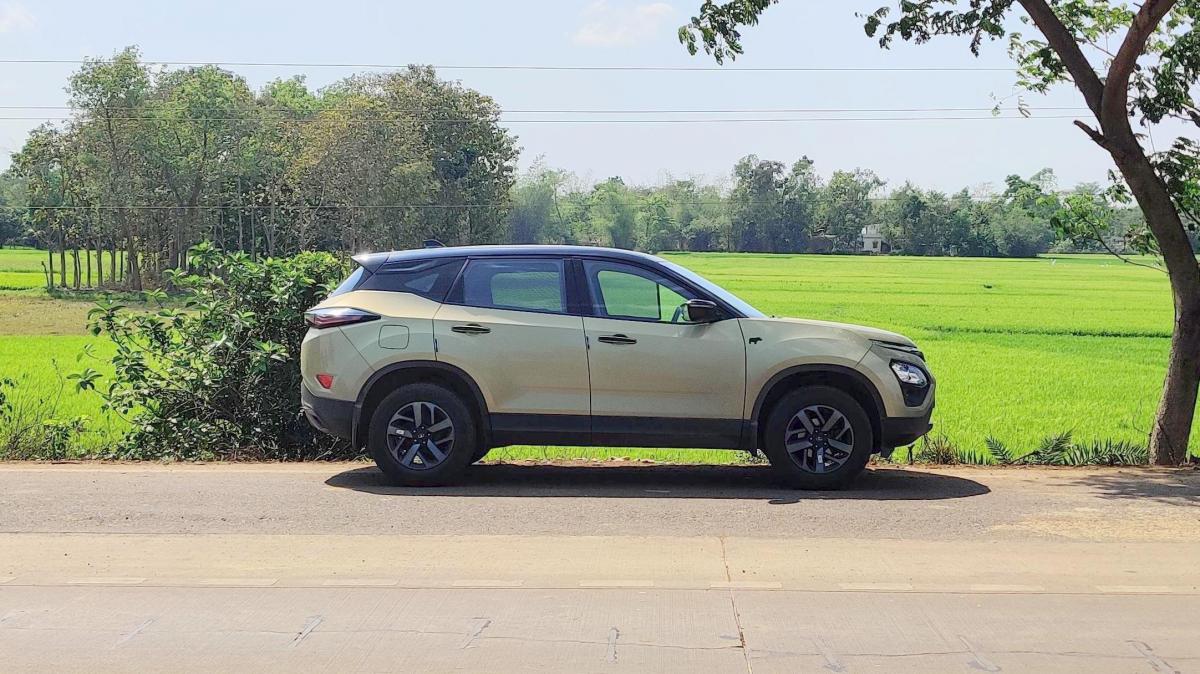
- Grassland Beige Colour – This may be my most controversial comment yet. I am now convinced that this colour indeed poses a challenge for others to judge the vehicle size/speed from a distance. More than a dozen times, I have seen people clearly mis-judge the distance to/from the Harrier at highway speeds. This is only on clear days and when the Sun is overhead (10 am – 3 pm), few times even with the DRLs ON. Didn’t face that with the Brown or Silver coloured vehicles with no DRLs I owned earlier. I may have contributed to an increase in my next insurance premium.
- Engine + auto box - The MultiJet 2.0 mated to 6-speed auto box is bliss. Post ~5K ODO, I am finding the smoothness is remarkable once the machine has warmed up. Even more after the engine oil change at 3rd service. My baseline is the K9K and the U2, so view could be skewed. Then again, a couple of others who drive petrols, brought up the smoothness – felt good.
- Tyres – 17 inch Apollo Apterras provide decent grip and comfort for a sedate driver that I am – don’t recall any tyre spins or skids. Road noise is bearable at 80-120 KMPH. Been on Sammrudhi (entire), Purvanchal (small section) and other concrete roads at up to 120 KMPH, without any alarm. Had a puncture recently near Guwahati - entire Hex M16 bolt was pulled out. Had to open the tyre to patch up from the inside. Lacking TPMS – didn’t really feel the need.
- Ride quality, NVH and handling – clearly a driver’s car, but passenger comfort is not lacking. Heavy steering and dimensions not-withstanding, it has felt pretty good to drive. NVH is surprisingly good. Most times we cannot hear much else other than the horns and the reverberations from large diesel engines like buses or trucks nearby (resonance), besides our own road/tyre noise. Everything else is kept out. I suspect the matting (aka lamination) is +vely contributing to this.
- Doors – too heavy for my liking. Family struggles to work with them. Everyone struggles with the boot lid weight and getting it to shut the first time. When parked at an angle, wife usually needs me to walk across to close/open the passenger side door. The width between the external door metal surface and the interior trim is a lot, not sure how much is necessary and wasted space, but +ve is ‘in a tank’ like feeling – a feeling that was reinforced recently when stone hit both passenger side doors. Didn’t think aftermarket damping is needed.
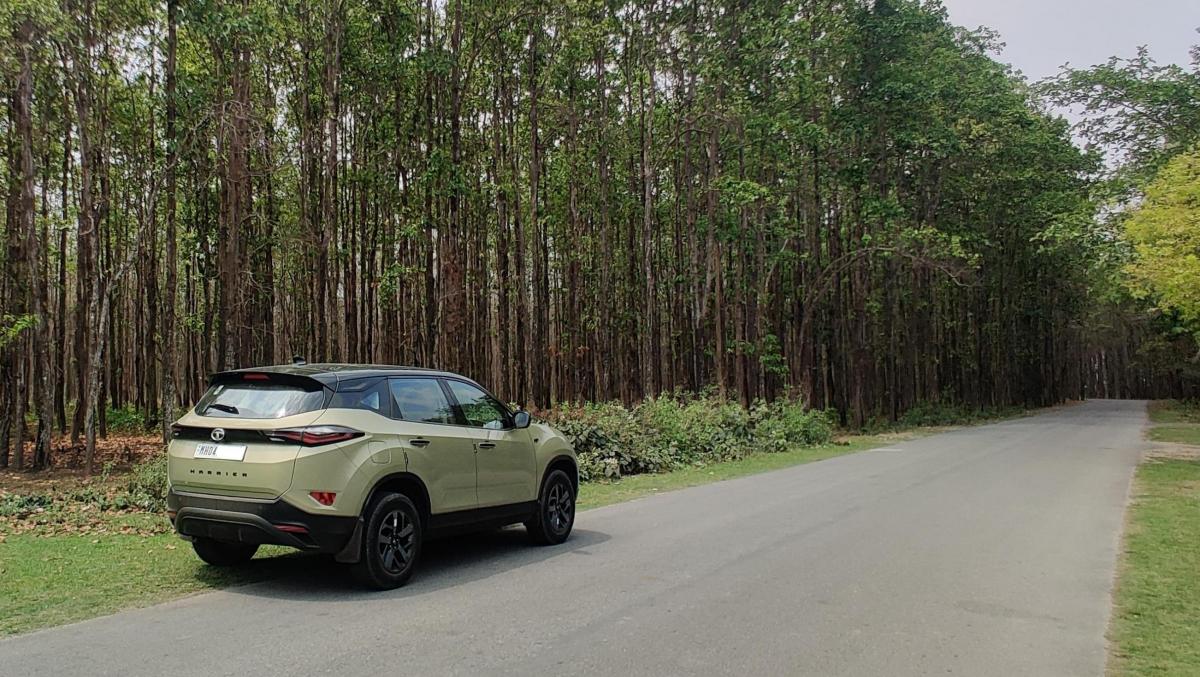
- Speakers – OEM speakers are good enough for me including the settings. Never felt the need to exceed volume level 5. For phone calls the volume level is different, around 12-14. I am not an audiophile.
- Voice commands – I have taken an effort to learn a few Android auto voice commands. Nifty ones like calling someone’s work or mobile, looking for petrol pumps or restaurants on the way, etc. Find it helpful. Harrier commands (like opening the sunroof) not tried yet.
- Hill Ascent / Descent – hill ascent is becoming universal. Hill descent is very comforting in the hills, works <40 KMPH only.
- Cruise Control – On the Sammrudhi and Purvanchal expressways, it was a lifeline. Everywhere else is unusable in our traffic conditions.
- Locking/unlocking – Still getting used to wireless key and frequently walk out with keys in my pocket. I love the fob sensors and the timed auto door locking. Gripe is the loud double beep each time the boot lid is lifted.
- Mileage – better than expected so far. Using TtT method getting 16-17 KMPL avg with 80% highway runs at 80-100 KMPH and the rest bumper-to-bumper city traffic. Lifetime low of 11 and high of 21. The MID shows 1-2 KMPL higher. I am a sedate driver.
- AC – good enough for the cabin size and Indian summer. Auto, but would have loved dual zone control. Also, for rear blowers on B pillars, most people struggle getting the vent angle right and just complain ac isn’t cooling enough.
- IRA app – first year is free and then paid I was told. It has limited functions and the most useful I found are the ‘I am here’ horn / lamp, GPS position on the map and intrusion alert. Also the trip history records every movement of the vehicle. Functions are nowhere near a Hyundai, where you can remotely start engine / AC or open/close windows, etc.
- TMSC app – this is free, though haven’t used it much. I can see summary of my previous services and reminders for upcoming services, insurance, etc. Basic stuff.
- Service – 1st and 2nd services are just checks and washing/cleaning. I only topped up DEF in those services. 3rd service is the first proper one with engine oil change, other fluids topped up, brake check and cleaning, tyre rotation, etc. Smooth experience so far. I do my balancing and alignment at trusted local FNG every 5K.
Overall, I hate that TML prefers to stay behind the curve in bringing much-needed features and then adds them to newer editions than mine. But the Harrier has still surprised me and my family mostly in a pleasant way. I am looking forward to holding on to this car for at least 5 years.
Check out BHPian comments for more insights and information.
- Tags:
- Indian
- Tata Harrier
- Tata Motors
News
10 things about Tata Harrier that I noticed on a 300km trip to Lonavala
The camera quality is much better than the Mahindra XUV700. As for fuel efficiency, I got 19 km/l on the highway.
BHPian loneagl09 recently shared this with other enthusiasts.
Did a 352km run from Satara to Lonavala. Free things of note:
- The highway average was around 19kmpl on mostly economy mode. However, in the crowded areas of Pune and Lonavala, it got down to single digits. Hence the slightly less mileage.
- Never had to use the sport mode, even in the ghat section.
- Wireless Android Auto disconnected once randomly and immediately reconnected.
- The ADAS is a godsend in crowded conditions. Blind spot monitor in particular helped a lot during unruly left-side overtaking.
- Automatic is necessary imo due to the left knee hitting the console. Not a problem in automatic but can't imagine pressing a clutch will be any easier.
- I've mentioned this before, but the new infotainment and instrument cluster UI is leaps and bounds ahead now.
- Bluetooth sometimes will not connect on starting the car. Happened 2 times in the journey. Similarly, if there's even a 5-minute gap between you switching on phone Bluetooth and the car, the car won't automatically connect to the phone.
- Central console sometimes creaks on high speed breakers or deep potholes. It's not a rattle and is very infrequent. No other rattles, even on extremely bad roads.
- The camera quality is exceptional (looking at you, XUV700), even at night. Weirdly I find my old i20 had an even better camera than Harrier.
- Ventilated seats are awesome, and one of those 'did not know I wanted till I used' kind of features.
Here's what BHPian MADMAX111 had to say about the matter:
How was the handling and ride comfort in ghats and plains??
BHPian loneagl09 replied:
Harrier's handling has typically rated great and my experience was no different. Mostly used the economy mode on the highway and City mode in the ghat section. The vehicle feels very planted even at higher speeds on turns. Body roll is well controlled. I can truly say I was less tired compared to a similar journey in my old i20.
Check out BHPian comments for more insights and information.
- Tags:
- Indian
- Tata Harrier
- Tata Motors
News
Tata Safari facelift spied alongside Mahindra XUV700
Like the Nexon facelift, the upcoming Safari will also receive a redesigned front fascia with an LED light bar.
The updated version of the Tata Safari has been caught testing once again. Unlike the test mules seen earlier, this test car has the production-spec front bumper.
Like the Nexon facelift, the upcoming Safari will also receive a redesigned front fascia, with what appears to be an LED light bar. The front grille will be reprofiled and the headlamps will now be housed inside vertical pods on either side of the bumper.
The Safari facelift could also receive some cosmetic changes to the rear. It could get new LED taillights with an LED light bar and other modifications. The Tata Harrier is also expected to receive similar updates.
Inside, the Safari and Harrier are expected to get a larger 10.25-inch touchscreen infotainment system, a full-digital instrument cluster and a redesigned centre console with a new gearshift lever. The SUVs are also expected to get ADAS.
The updated Harrier and Safari are expected to carry forward the same 2.0-litre, 4-cylinder diesel engine that makes 168 BHP and 350 Nm. The engine will be paired with either a 6-speed manual or a 6-speed automatic. The carmaker could also debut its new 1.5-litre turbo-petrol engine on the updated Harrier and Safari. This unit puts out 168 BHP and 280 Nm.
Source: Anvay Sheolikar via Rushlane
News
Found a factory QC checklist in my Tata Safari. What could it mean?
I am not sure whether it belongs to my car or just a piece of trash from another car. It is for Harrier and Safari, going by the model H/S mentioned in the sheet and is from factory going by the stamps.
BHPian IamGroot recently shared this with other enthusiasts.
Recently I reclaimed my life, i.e., took ownership of Tata Safari XZA+ Adventure Persona Tropical Mist variant. I have followed the Tata Safari review thread on team-bhp from day one till 166 pages. It was a tough decision, especially Toyota Hycross coming in as last-minute option. More on the decision making and delivery experience in another thread. In this thread wanted to highlight something that I came across during a routine clean-up of my SUV interiors.
I had minor niggles post-delivery, engine check light coming on and going away after a long ride. The dreaded DPF regeneration issue, I guess. This in addition to the 5-6 attempts it takes to close the tail gate. During PDI I also saw water on last row. The sales team attributed this to their cleaning process.
Post a weekend drive to Mahabaleshwar, vehicle was up for an interior wipe down. Those red mud marks on light seats look bad. During wipe down I found a small piece of paper in a crevice between front passenger seat and right arm rest. A Quality control check list of sorts. I am not sure whether it belongs to my car or just a piece of trash from another car. It is for Harrier and Safari, going by the model H/S mentioned in the sheet and is from factory going by the stamps. Also, the tail gate issue I am facing is precisely one of the items on the QC sheet. It says OK to most items but not for the tail gate. Instead, it mentions a 6-digit number, could be defect ID.
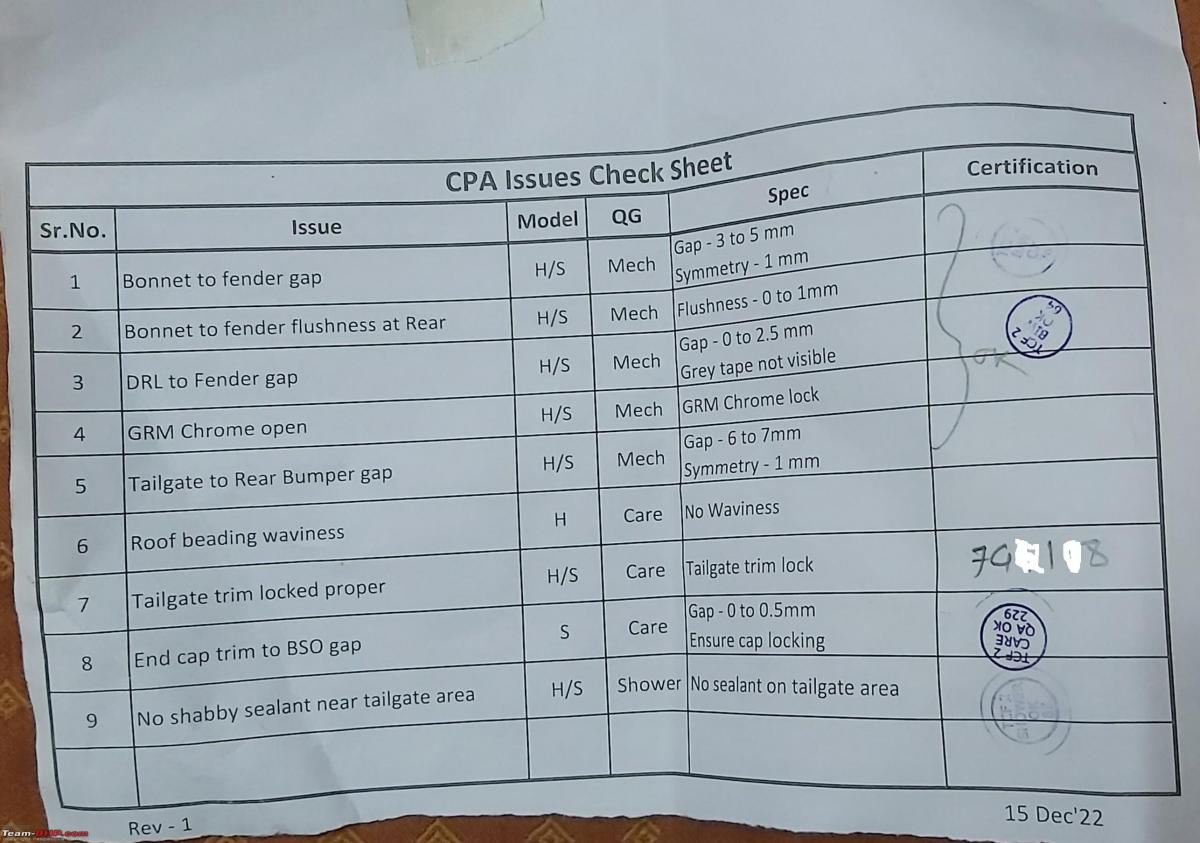
I am curious to know what the sheet means, especially the "spec" column, and why only nine items are part of this sheet? Are these like known issues and they have a special check list to address these issues? Paradoxically If Tata has a special checklist of know quality issues, then they are doing an excellent job of making sure these issues are not passed-on to customer and then not so respectable job at assembly, since these issues should not be there in first place.
It also raises another question. The VIN of my car MAT123456PXA78912(Masked except for 10th and 12th character) interprets to Jan 2023. And if this piece of paper is indeed from my car them the timestamp of 15 Dec indicates it is not January 2023 manufactured car.
Thanks.
Here's what BHPian abirnale had to say on the matter:
Maybe - the check-sheet might just be prepared and printed on 15 Dec 22, used on whenever it was used thereafter? A PDI wont be such a short PDI - could be a part of one team’s check on assembly line that messed up and not finding right record instead of stopping it from going out of factory or enforcing redo, they chose to send it out and so you got it with tailgate issue?
The best could be to work with TaMo folks and ask them to verify: if any reliable source in TaMo can cross check your VIN, Defect remarks etc to be from factory floor or something from Dealer. If nothing else - just leave it here and drive car. These bugs in your head tend to become larger over period of time - don’t loose your peace of mind over this.
Here's what BHPian srh had to say on the matter:
This would most likely be an output from a previous inspections where this defect list would have been compiled. This checklist would then be populated during re-inspection after concerned workers confirm that issues are fixed.
Of as you say, it could be a special additional checklist to cover defects that have been observed in many vehicles produced.
The VIN number is stamped at a specific work station in the manufacturing process. So while this inspection maybe happened on 15th Dec 22, the vehicle reached the stamping work station in Jan-23.
Here's what BHPian condor had to say on the matter:
The date of inspection is not given any where in the remarks/observations/responses on that sheet.
There is a date on that sheet - but it is printed. Could be date when the checklist was printed.
(As practice, we put dates in the footer of important documents, often to track versions etc).There is no identifying info to say that this checklist is for your Safari.
Why only 9 items ? Cant expect one person doing the full QC of a car - it's better when split between a few checkers.
Here's what BHPian svsantosh had to say on the matter:
Having experience in leading Operations @ a mechanical engineering cum SPM equipment manufacturing company I can safely say that this the shoddiest piece of official document I have ever seen.
- Traceability - ZERO (IamGroot - this may very well be another cars paper left in your car glove box
- Branding - zero
- Document # - zero
- Version # - zero
I can go on, but my God, if this is the quality of document used at a QA/QC dept; God save them.
Read BHPian comments for more insights and information.
News
Rumour: Tata Harrier & Safari facelift to debut in October
Tata could also introduce its new 1.5-litre turbo-petrol engine on the Harrier and Safari.
According to a media report, Tata Motors is likely to debut the updated Harrier and Safari in October 2023, with the price announcement expected before Diwali.
The facelift versions of the Tata Harrier and Safari have already been spotted testing on the road. Both models are expected to get a redesigned front fascia inspired by the Harrier EV concept that was showcased at Auto Expo 2023. The SUVs could get an LED light bar up front with slim taillights at the rear, also connected by an LED light bar.
The 2023 Harrier and Safari are likely to get a few changes on the inside. Spy images have revealed a larger touchscreen infotainment system and a fully digital instrument cluster. We also got a glimpse of a new stubby gear lever on a Harrier Automatic test mule.
Tata is likely to retain the FCA-sourced 2.0-litre diesel engine. This motor develops 168 BHP and 350 Nm and will be paired with either a 6-speed manual or a 6-speed automatic transmission. Moreover, the carmaker could also introduce its new 1.5-litre turbo-petrol engine, which makes 168 BHP and 280 Nm.
Source: Autocar India
News
Tata Harrier facelift with revamped interior spied
The Harrier / Safari facelift is expected to get a larger touchscreen infotainment system and a digital instrument cluster, among other updates.
A test mule of the Tata Harrier facelift has been spotted once again. The latest images also reveal the SUV’s revamped interior.
Just like the prototypes spotted earlier, this one too is heavily camouflaged. However, there is barely any camouflage hiding the new bits inside the cabin. While the overall design of the dashboard looks familiar, the test car is equipped with a larger touchscreen infotainment system and a fully-digital instrument cluster. Tata Motors has also made some changes to the centre console, which now has a stubby gearshift for the automatic transmission.
On the outside, the updated Harrier is expected to receive Harrier EV concept-inspired design changes. It could get a revised front grille with sleeker LED daytime running lights. This particular test vehicle, however, is equipped with circular dummy lights.
While the rear of the car looks fairly standard, the production version could get a reprofiled bumper and an LED light bar between the taillights.
The Harrier facelift is expected to carry forward the same 2.0-litre, 4-cylinder diesel engine that makes 168 BHP and 350 Nm. The engine will be paired with either a 6-speed manual or a 6-speed automatic. The carmaker could also debut its new 1.5-litre turbo-petrol engine on the updated Harrier and Safari. This unit puts out 168 BHP and 280 Nm.
Source: Gaadiwaadi
- Tags:
- Indian
- Tata Harrier
- Harrier
- spy shots
News
How I eventually bought a Tata Harrier: 7 things I love and 4 misses
I did a test drive of the Toyota Innova Hycross but it failed to impress me. The car looked more MUV-ish than an SUV.
BHPian loneagl09 recently shared this with other enthusiasts.
Just got the XZA PLUS OPTION delivered yesterday and would like to post initial impressions.
Options considered before getting the Harrier
XUV700
The most obvious comparison. But a few things steered me away:
- The digital instrument cluster being too ‘in the face’. I like the traditional cowl with the cluster some distance away.
- Not a fan of the white interior aesthetic
- No ventilated seats
- The biggest one for me – the whole software experience was unsatisfactory – laggy touchscreen, the Alexa would not work during TD and the biggest one for me – the cameras are laggy- stuff on the camera seems to be moving at 10fps! This, I thought, was unforgivable in any car.
HECTOR
- Thought all that chrome looked gaudy
- A touchscreen for all functions is a big no to me
COMPASS
Excellent driving, great safety across all variants and a premium experience but:
- The new ‘club’ edition that I got an ad for is basically the base version
- The base edition is pretty expensive as is and features gate-walled to higher versions ( eg sunroof)
- Understated road presence (my opinion)
SKODA, KIA AND VW
Steered clear because of all the horror stories on this forum. Also, no Skoda and Kia where I live. I did TD both the 1L and 1.5L Virtus and loved the drive. My brother has a Venue and remarked that the VW 1L turbo petrol seemed smoother and better than the Hyundai 1L turbo petrol. Don’t know how that works out. But the red interiors were not great to me. The red, especially, seemed garish, too bright. The AC also seemed underwhelming.
TOYOTA HYCROSS
Looked too MUV-ish to me, plus the interiors failed to impress (personal opinion).
GRAND VITARA
Have a friend’s relative who works in Nexa and he advised against getting one, as it was full of niggles and rattles. I did still go and take a look:
- The interiors look great and the stitched parts look premium.
- The HUD is a really great feature that I would love to see expanded across other brands.
- Ventilated seats and 360 degree camera make for useful additions.
However, the underwhelming 3 pot review in this forum made me think about spending 20 lakh plus. Also personally, the exterior did not impress me. Maybe larger wheels would have helped.
TATA HARRIER
I only mention this at the end because I ended up buying it. I actually TD it around the VW visit and the drive quality and new interiors still stood out to me after Virtus and Compass TDs.
Things I love
- The interiors are beautiful in person. The red is much more ‘denatured’ than the Virtus. Closer to Astor but more understated. The ventilated seats are a joy to use and are firmly in the ‘did not know I needed them till I used them’ category.
- The infotainment system in TD is a breeze to use, and the one in the production model is even smoother. The infotainment is mostly brown and yellow and is maybe a bit too understated. But I am not complaining and love this direction Tata has taken. In fact, it may be the best-looking system (UI-wise) amongst Suzuki, Mahindra, VW and MG. Hyundai also has great-looking infotainment, and I believe at this point it comes to personal choice. I just loved the layout and colours of Tata more. Never thought I’d say that. I mean, I have seen videos of the old Harrier infotainment.
- The digital dial has a proper cowl and pleasing colours (think yellow, brown umber, shades of light green). It’s an unusual combination of colours for a car system. It’s very understated and I am surprised Tata actually went ahead with it. The centre part has all sorts of scrollable features like trip, live mileage etc. and even a cool graphic of power and torque. In fact, there’s so many symbols and alerts (all with different notes) that I am still working through their meanings. Even Tata SA does not seem to know all about ADAS.
- The ADAS features are basic and definitely not level 2, as some videos seem to claim. For instance, there’s no adaptive cruise control. But the ‘car protective’ functions are pretty good – and do work flawlessly. Except for autonomous emergency braking, I’ve tested all the functions (touch wood). I’ve seen discussions regarding their efficacy and can say they definitely have their place even in Indian conditions. Rear cross-traffic alert, door opening alert (radar checks oncoming traffic and alerts if it's safe to open door to exit) and overtaking alert have all been very useful. Headlight assist, in particular, automatically makes me a better driver. ADAS features can be individually switched off and if on, their volumes and sensitivity can be tweaked. Lane departure warning will remain switched off, which is honestly useless in city and most highway conditions.
- The 360 camera is again a useful addition and the quality of the image is surprisingly great. Each camera can be individually switched on. Helped me in a couple of tight spots. Eg – bikes parked on both sides of a narrow road with some sticking out. No longer do I have to rely on the judgements of random people guiding me frantically through a maze of ill-positioned vehicles. The 3d camera is a cool addition but more of a gimmick. Switch on the right or left indicator and the corresponding camera will display on the infotainment. This is much better in my opinion than say, Alacazar, which displays on the torque/speedometer dial according to direction. In my TD of Alcazar I found that the turning steering wheel often blocks the camera view.
- I won’t say much about exterior looks, as these are basically unchanged except for minimum red accents. I absolutely love the butch looks, and they played a major factor in making the choice.
- Again, the engine, and steering has been exhaustively discussed and are basically unchanged. The hydraulic steering does come across a bit heavy though.
Some misses
- Haven’t figured out a way to start the phone app directly from the steering buttons.
- Wish they had a dial which displays temperature continuously like Hyundai. For now, the temperature is only briefly shown when I turn the climate control dial. This can be easily made a part of the display - in the status bar for example.
- No volume control knob – seriously Tata?
- Did not find a way to switch off the infotainment display. Swiping left brings up a screensaver-like display with a clock.
I guess this is it.
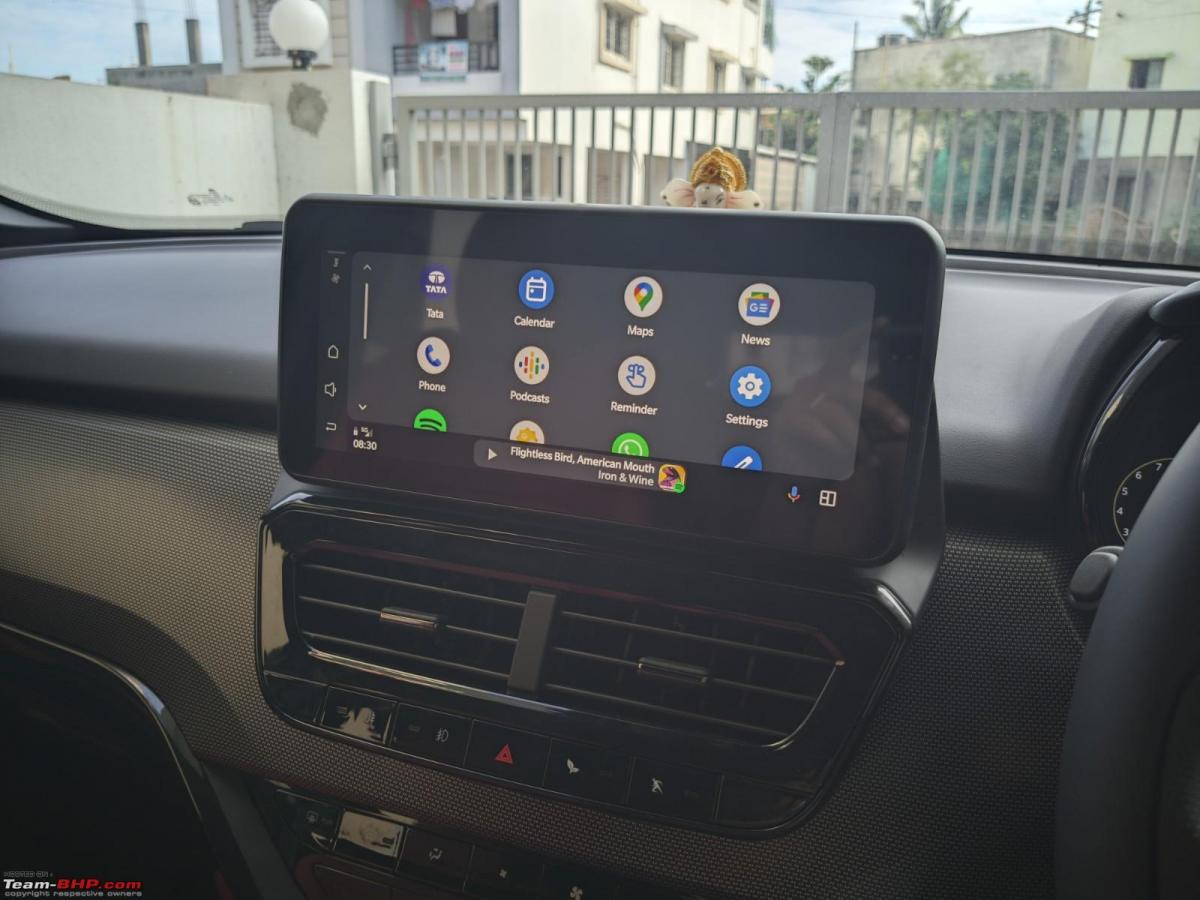
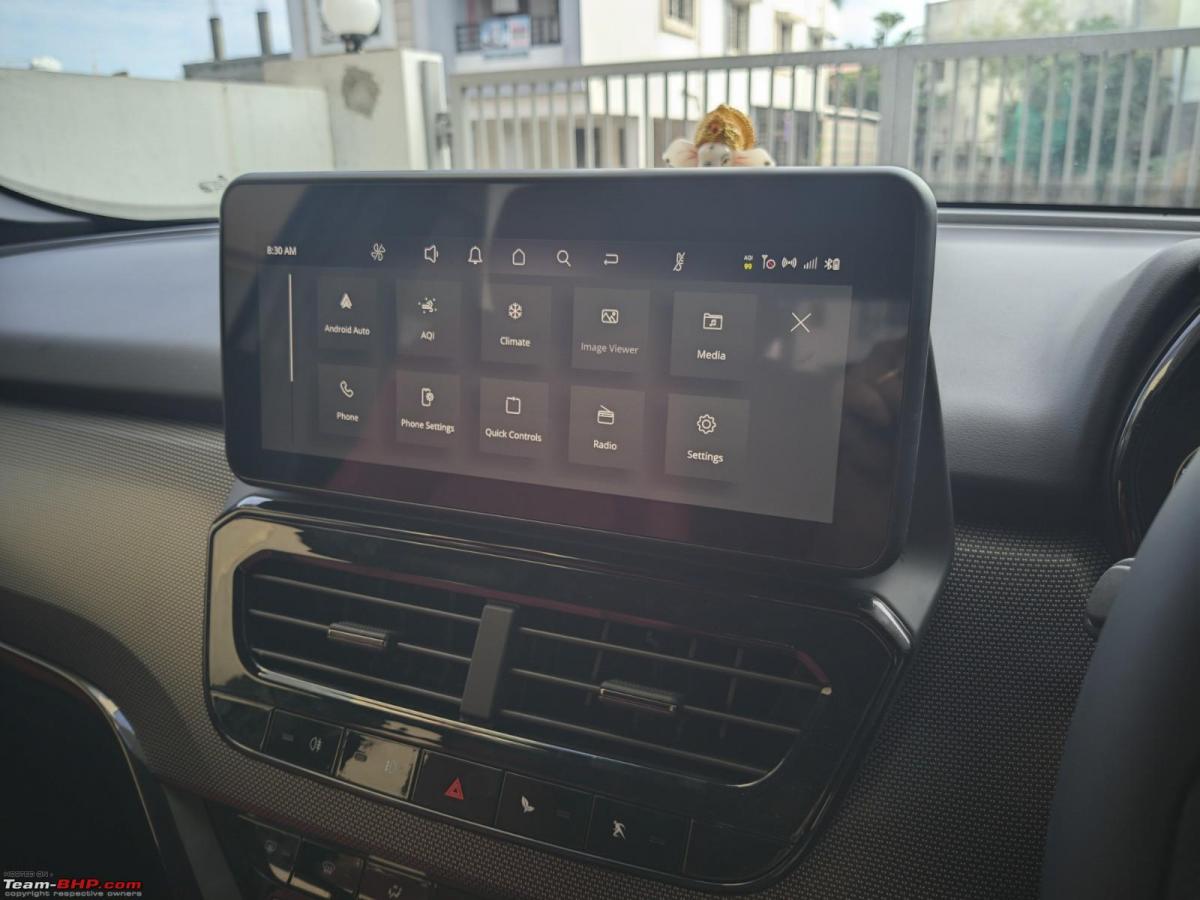
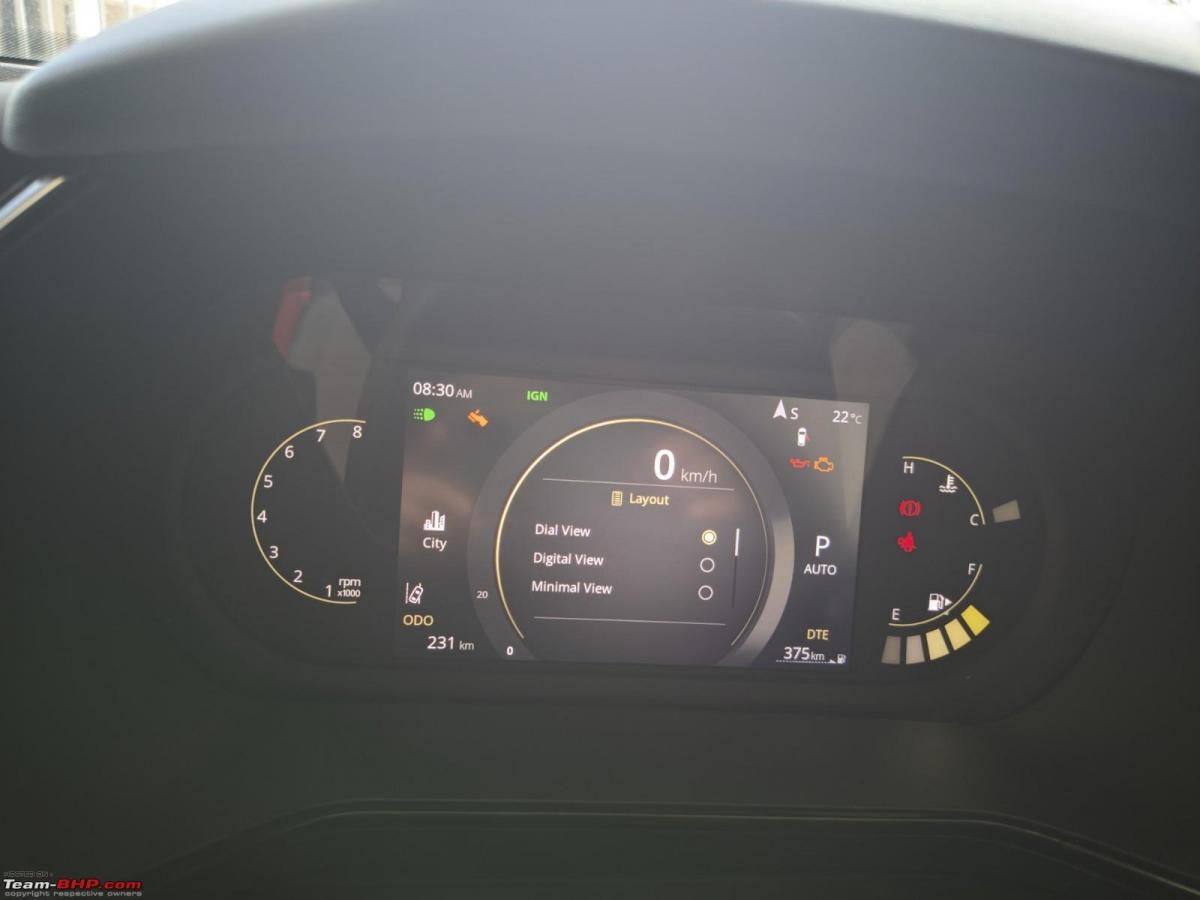
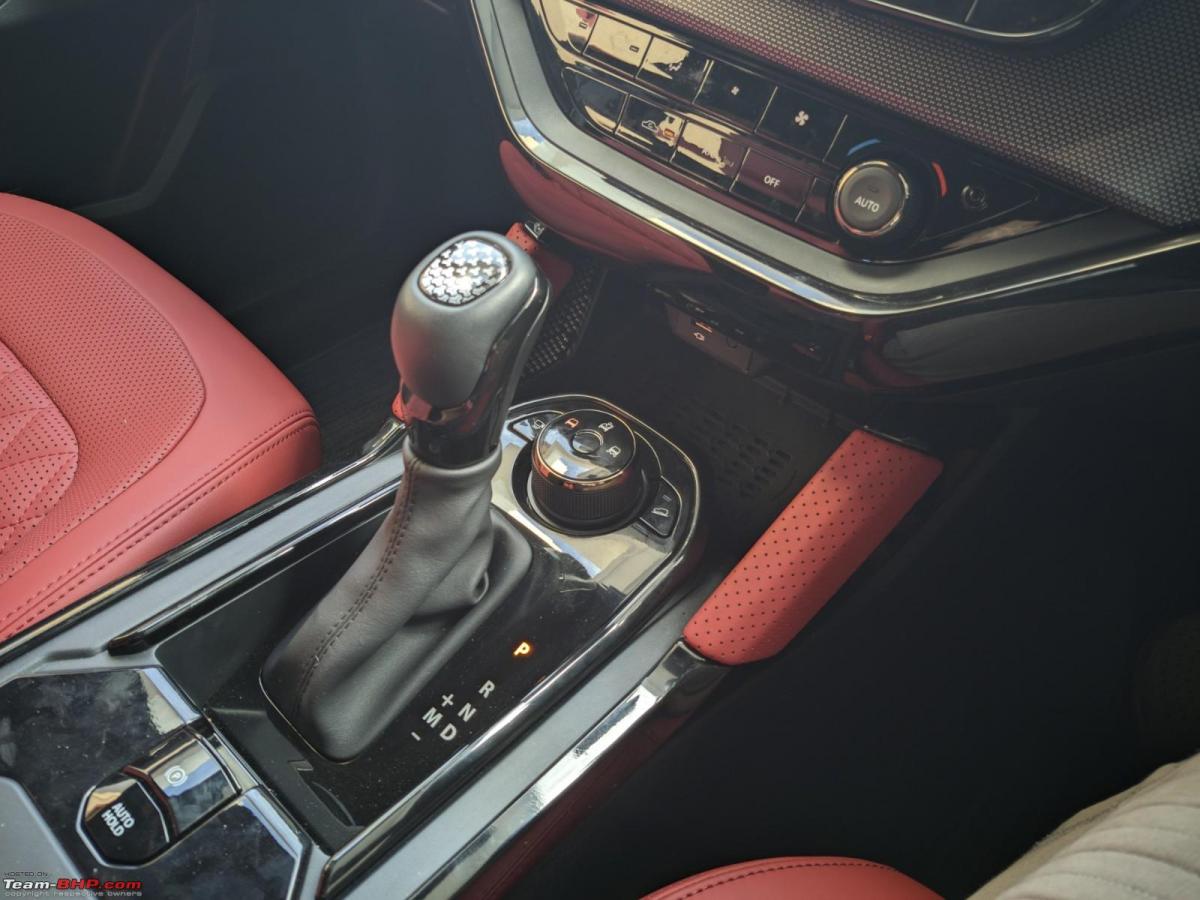
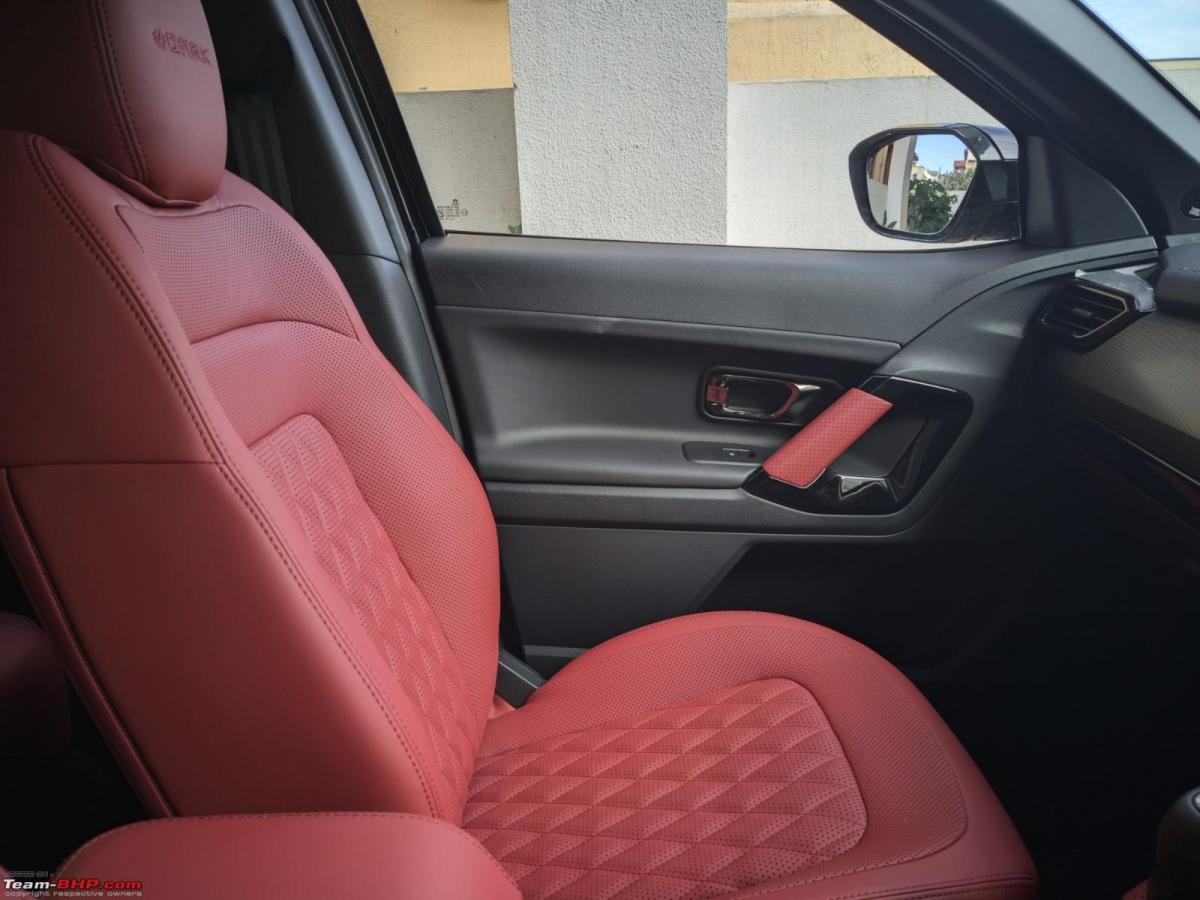


Check out BHPian comments for more insights and information.
- Tags:
- Indian
- Tata Harrier
- Tata
News
15-20L SUV war: MG Hector vs XUV 700 vs Harrier vs Seltos vs Creta
Enthusiasts can blast the Hector all they want, but the fact is, it is unbeatable as a spacious, comfortable, family cruiser with a softly sprung suspension.

MG Hector

What you'll like:
- Big size & lots of bling for the money! We find the Hector to be well-priced
- A spacious cabin that can easily seat 5 adults. Massive 587 litre boot too
- Refined 1.5L petrol is mated to a smooth CVT
- Fiat-sourced 2.0L diesel is simply fantastic
- Compliant ride quality. Suspension is tuned for comfort
- Lots of kit (panoramic sunroof, 360-degree camera, electric seats & tailgate etc.)
- ‘Connected’ Tablet ICE with an embedded SIM & lovely sound quality
- 5-year / unlimited km warranty with roadside assistance
- Top safety equipment includes 6 airbags, ESP, HSA, all-wheel disc brakes, TPMS & more
What you won't:
- Awkward styling on the side & rear profiles. Looks weird from some angles
- Sloppy high-speed handling, noticeable body roll & easy understeer
- The turbo-petrol engine is “adequate” at best. Nothing for enthusiasts here
- Petrol CVT combination is a gas guzzler. Realistically, you can expect ~10 km/l
- No Diesel AT (Creta, Seltos, XUV500, Hexa offer this combination, which we love)
- Some annoyances like the ~6 meter turning radius, strange rpm meter (digital)…
- Small after-sales network. Service quality & long-term reliability are big unknowns
- Don’t get blinded by the British branding. This is a Chinese car
Tata Harrier

What you'll like:
- Stunning looks & strong road presence. Solid build too
- Well-priced for the package on offer
- Classy, spacious cabin with comfortable seats & a chilling air-con
- Fantastic 9-speaker audio system. Sound quality & bass are enjoyable
- The 168BHP, 2.0L diesel offers good performance
- Smooth & competent 6-speed automatic transmission
- 205 mm of ground clearance + terrain response system. Latter will make monsoon driving safer
- Topnotch safety kit includes 6 airbags, ESP, break reminder, hill hold, brake disc wiping & more
- Features such as the panoramic sunroof, Eco & Sport modes, auto headlamps & wipers, cruise control…
What you won't:
- Concerns over niggles & long-term reliability. Few customers have reported problems
- Heavy steering gets cumbersome at parking / u-turn / crawling speeds (<5 km/h)
- Although improved, the Harrier's steering @ 120 km/h is still a level too sensitive
- Diesel engine does get loud at 3,500 rpm & its engine note is quite sad too
- No petrol option (almost all competitors offer it). No AWD for enthusiasts either
- Harrier AT’s focus is on smoothness & comfort; gearbox is not the most responsive
- Service visit every 6 months / 7500 km (12-months is the norm today)
- Tata's after-sales service quality is a hit or miss. Remains a gamble
Hyundai Creta
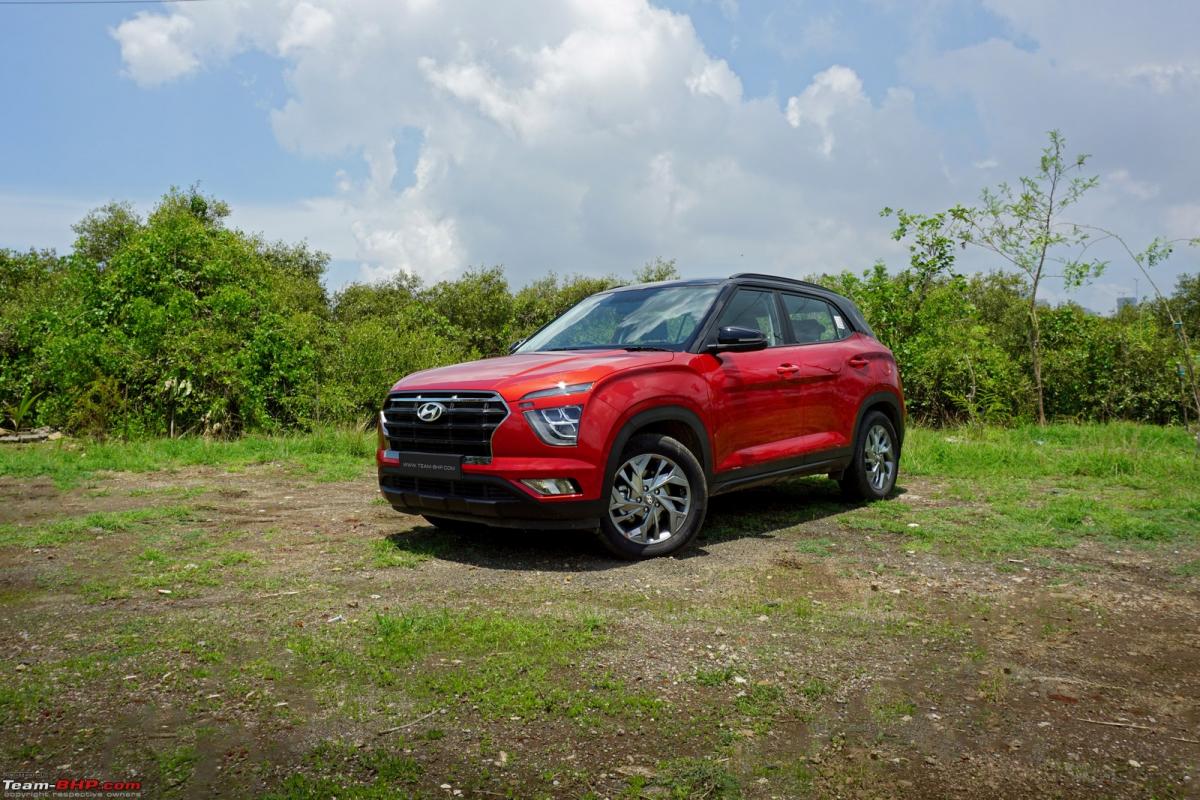
What you'll like:
- A superbly engineered all-rounder that delivers a premium experience
- We find the Hyundai Creta to be well-priced for what it offers
- User-friendly interiors with sufficient space & good-quality parts
- Loved the 1.4L turbo-petrol & 1.5L diesel. These are fantastic engines
- Smooth & competent automatic gearboxes available. With the useful "auto-hold" feature too
- Sorted road manners & handling for a Hyundai, including on the highway. You will be surprised!
- The Creta's safety package includes 6 airbags, ESP, all-wheel disc brakes, TPMS etc.
- Impressive kit (panoramic sunroof, paddle shifters, Bose sound system, cooled seats, cabin air purifier & loads more)
- Hyundai's competent after-sales service, fuss-free ownership & upto 5-years standard warranty
What you won't:
- Scored just 3-stars in the GNCAP crash tests
- Oddball love it or hate it styling. We find the Creta's exterior design to be too weird & futuristic
- Firmer suspension isn't as cushy as the 1st-gen Creta. It is more comfortable than the Seltos though
- Back seat's width makes it better for 2 adults and a kid, rather than 3 adults
- Some misses (no auto wipers, 360-degree camera, illuminated window buttons, full-size spare tyre on top trims)
- Dual-clutch ATs (like the Hyundai Creta Petrol DCT) have a history of poor reliability in India
- Diesel’s 113 BHP & 250 Nm – although adequate – are the lowest in the segment. Old 1.6L CRDi was superior
- No manual transmission available with the fast 1.4L Petrol (Seltos offers this combo)
- You get bigger SUVs & Crossovers for the same money (e.g. Hector, Harrier)
Kia Seltos

What you'll like:
- A superbly engineered all-rounder that delivers a premium experience
- Handsome, contemporary styling. Looks very sharp
- We find the Seltos to be well-priced for what it offers
- Nice, user-friendly interiors with sufficient space & good quality
- Loved the 1.4L turbo-petrol & 1.5L diesel. They are BS6 compliant too
- Both the automatics - Diesel AT & Petrol DCT - are simply fantastic!
- Mature on-road behavior, including at highway speeds. A+ brakes as well
- Unusually wide variant offering. Seems there is something for everyone
- Safety kit includes 6 airbags, ESP, all-wheel disc brakes, blind spot monitor, TPMS etc.
- Impressive kit (360-degree camera, HUD, front parking sensors, Bose sound system, cooled seats, cabin air purifier & loads more)
What you won't:
- Barely managed 3-stars in the GNCAP crash tests (full discussion)
- Firm suspension. Liveable, but bad roads will bother you (especially on 17" wheel variants)
- Back seat's width makes it better for 2 adults and a kid, rather than 3 adults
- Niggles are being reported by owners (details here)
- Some misses (illuminated window buttons, thinner spare tyre on top trims, no dual-tone option on GTX+ / HTX+)
- Dual-clutch ATs (like the Petrol DCT) have a history of poor reliability in India
- Diesel’s 113 BHP & 250 Nm – although adequate – are the lowest in the segment. Creta 1.6L is faster
- Extremely confusing & complicated variant spread. We still haven’t gotten the hang of it!
- Kia's after-sales service quality is an unknown. We await details in our ownership reports
- You get bigger SUVs & Crossovers for the same money (e.g. Hector, Harrier, XUV500)
Maruti Grand Vitara
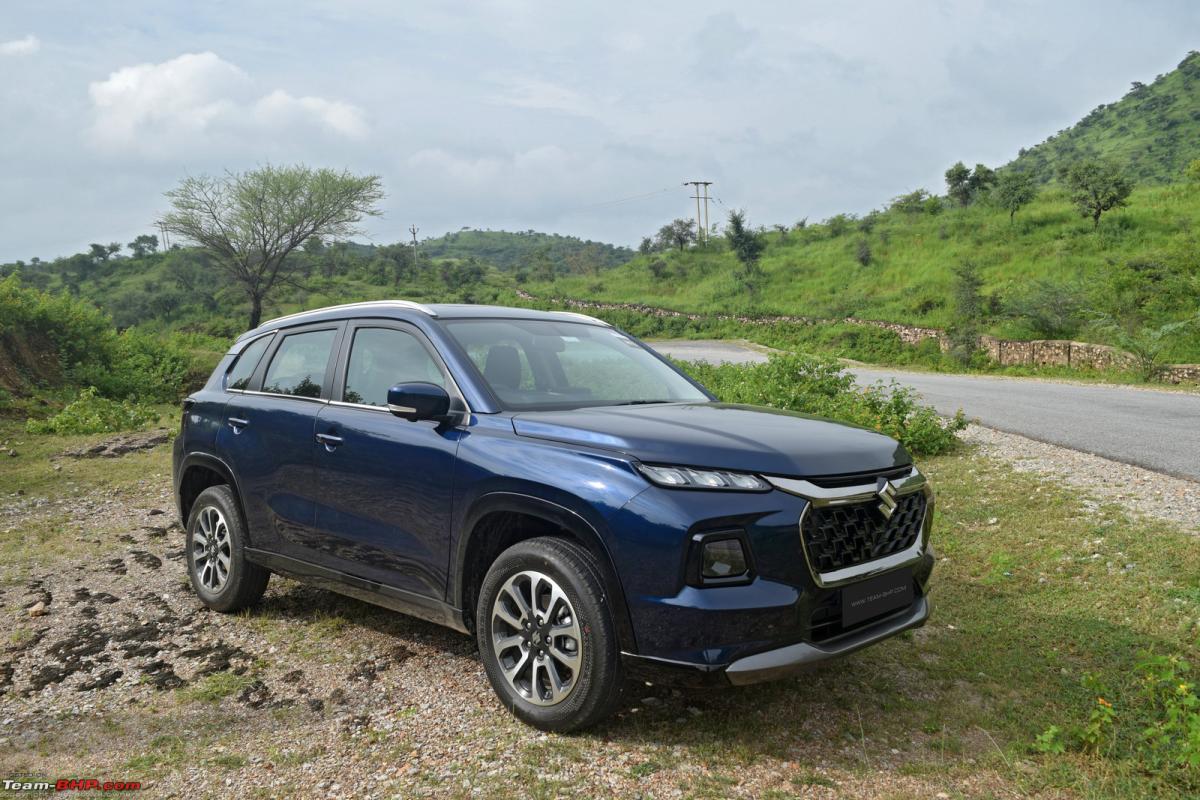
What you'll like:
- A competent hybrid car for the mass market
- 20+ km/l FE in city driving conditions makes the Grand Vitara cheaper to run than a diesel!
- Lower emissions will appeal to environmentally-conscious buyers. And those who aren’t ready for an EV yet
- Toyota’s reliability & expertise in hybrid systems is very reassuring in the Maruti
- Seamless Hybrid system that makes driving a breeze. A car you will enjoy driving in traffic
- Maruti's AWD system provides impressive soft-roading capabilities. Can get you out of tricky situations when touring
- Compliant ride quality coupled with balanced driving dynamics
- Well-equipped with features such as driving modes, panoramic sunroof, 360-degree camera, ventilated seats, wireless smartphone charging, connected car features, wireless Android Auto + Apple CarPlay and more
- Maruti’s excellent after-sales service, wide dealer network & fuss-free ownership experiences
- Does most things well, but doesn’t excel in any particular area (other than fuel economy)
What you won't:
- Practicality is compromised due to reduced boot space in the full-hybrid variant
- Interior quality and fit & finish are underwhelming at this price point
- AllGrip AWD is only available in a single MT trim. Missed opportunity to market a USP
- Interior is narrow and doesn't feel as roomy as some competitors. Rear seat is best for 2 adults
- Lacks the outright performance of the competition. Runs out of steam above 110 km/h
- Not as engaging to drive as the German competitors, or the Creta / Seltos turbo-petrols
- NVH levels from the drivetrain are surprisingly poor for a hybrid. Sounds from the 3-cylinder engine, electric motor and brake vacuum pump filter into the cabin
- The Honda City’s Hybrid system is smoother, more sophisticated & more refined
- Missing features such as rain-sensing wipers, premium audio + subwoofer, electric seats, electric parking brake, LED interior lighting, etc.
- Does most things well, but doesn’t excel in any particular area (other than fuel economy)
Toyota Urban Cruiser Hyryder
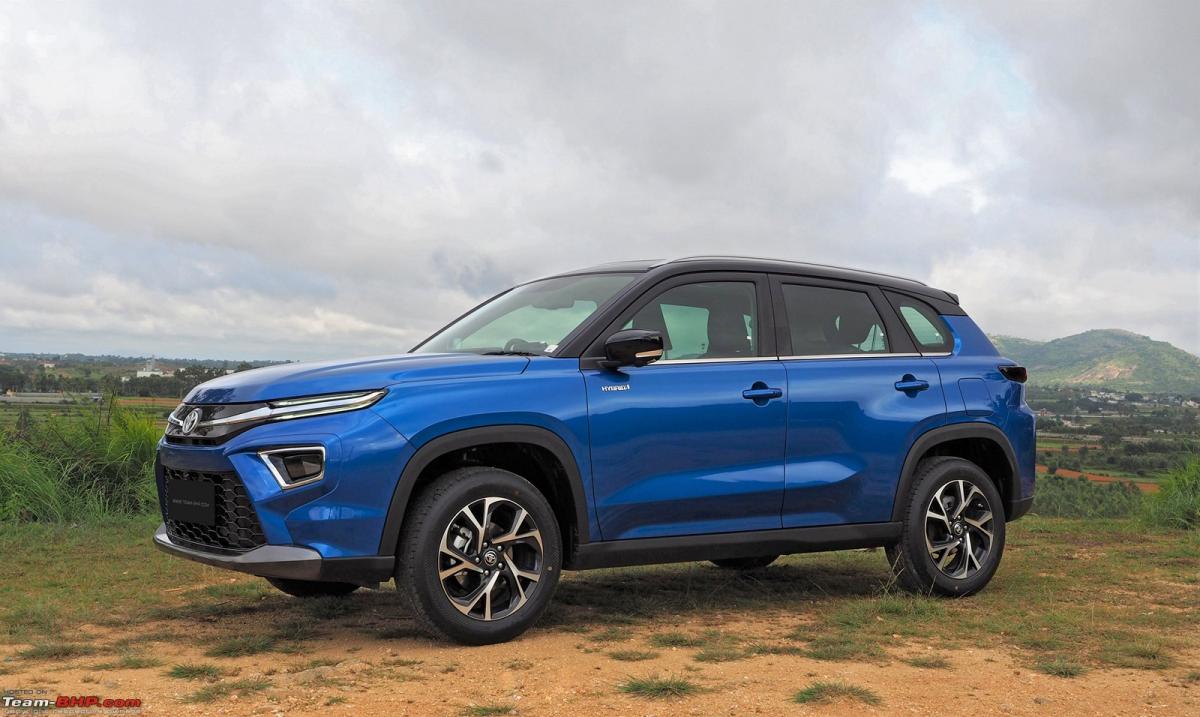
What you'll like:
- Very good attempt at making a mass-market hybrid car
- 20+ kmpl FE in city driving conditions makes the Hyryder cheaper to run than a diesel!
- Seamless hybrid system that makes driving a breeze. A car you will enjoy driving in the city
- Lower emissions will appeal to environmentally-conscious buyers. And those who aren’t ready for an EV yet
- Toyota’s reliability & expertise in hybrid systems is very reassuring
- Compliant ride quality coupled with balanced driving dynamics
- Well-equipped with features such as driving modes, panoramic sunroof, 360-degree camera, ventilated seats, wireless smartphone charging, connected car features, wireless Android Auto + Apple Carplay and more
- Only Crossover in this segment to provide AWD capability
- Toyota’s after-sales quality is usually regarded as top-notch by owners
- Does most things well, but doesn’t excel in any particular area (other than fuel economy)
What you won't:
- Practicality is compromised due to reduced boot space in the full-hybrid variant
- Quality of interior plastics feels more “Maruti” than Toyota. Frankly, the S-Cross cabin feels better in quality
- Interior is narrow and doesn't feel as roomy as some competitors. Rear seat is best for 2 adults
- Missing features such as rain-sensing wipers, premium audio + subwoofer, electric seats, electric parking brake, LED interior lighting, etc.
- Lacks the outright performance of the competition. Runs out of steam above 110 kmph
- Not as engaging to drive as the German competitors, or the Creta / Seltos turbo-petrols
- NVH levels from the drivetrain are surprisingly poor for a hybrid. Sounds from the 3-cylinder engine, electric motor and brake vacuum pump filter into the cabin
- AWD available only on the MT (not the AT) and the mild-hybrid (not full-hybrid)
- The Honda City’s Hybrid system is smoother, more sophisticated & more refined
- Does most things well, but doesn’t excel in any particular area (other than fuel economy)
Volkswagen Taigun
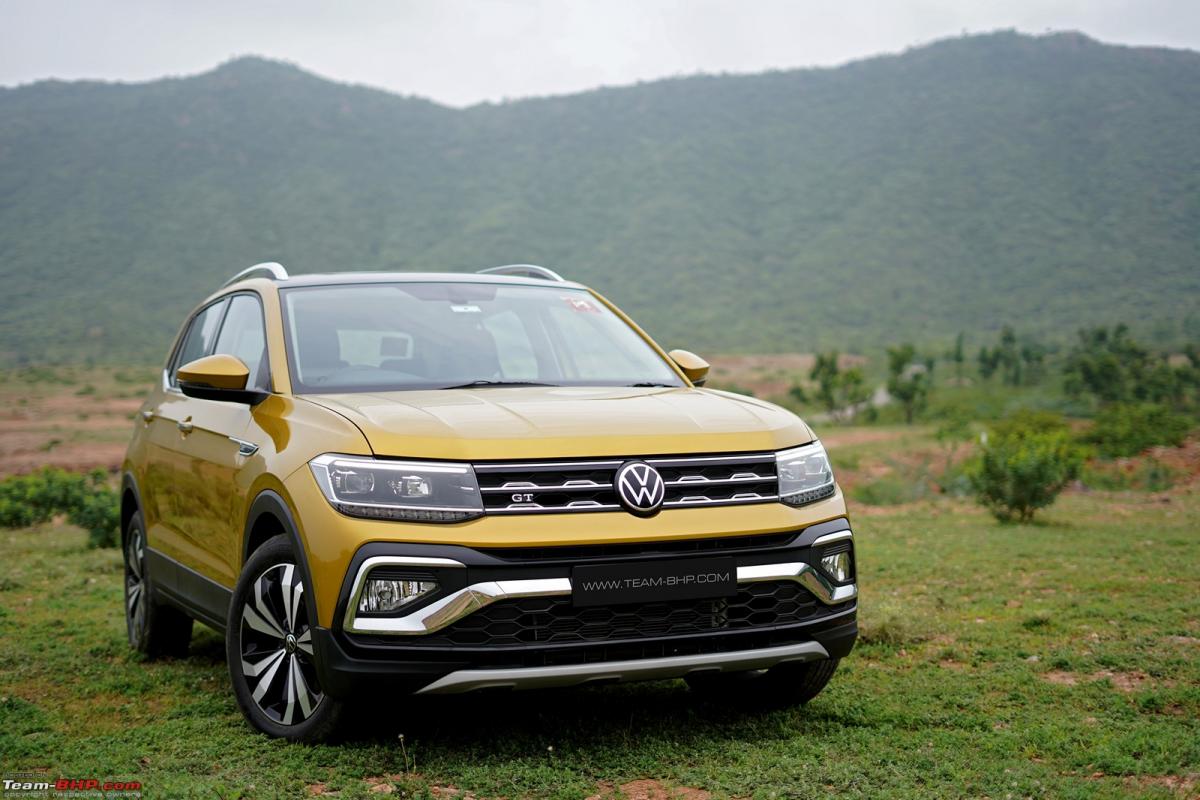
What you'll like:
- Has its own fresh, European character and complements its cousin (the recently launched Skoda Kushaq) nicely in a segment dominated by Indian, Korean and Chinese SUVs
- Unmistakably VW styling matched with solid European build quality
- Cabin has good legroom to offer, supportive seats, perfect ergonomics & lots of storage
- 148 BHP engine makes the Taigun one of the most fun-to-drive crossovers in the segment!
- Sporty 1.0L & 1.5L turbo-petrols are mated to slick 6-speed MTs & smooth ATs
- Sorted suspension offers a balanced ride & handling package
- Safety features include up to 6 airbags, ESC (all variants), 3-point seatbelts for all, electronic differential lock, brake disc wiping, multi-collision brake and more
- Features like active cylinder tech, ventilated seats (weirdly 1.0 TSI only), sunroof, 10-inch touchscreen with wireless Android Auto and CarPlay, auto headlamps & wipers etc.
- Advantages over the Kushaq = a top AT variant with 6 airbags, design that stands out more, cabin 'feels' better, fabric seats are executed in a nicer manner...
- 5-star GNCAP safety rating - full details here!
What you won't:
- No 1.5L diesel is a major disadvantage in a world where petrol costs over 100 bucks/litre
- GT customers will need to choose between the rock (potential DQ200 transmission problems) and a hard place (GT manual variant misses out on many top-end features)
- Narrow cabin width makes a 5th adult completely unwelcome. Best for 4 onboard
- Interior colour scheme and quality don't feel up to traditional VW standards. Some polarising details too (chrome outside, painted plastics inside...)
- Sure lacks the street cred / presence offered by some competitors
- VW’s after-sales service can be a hit or miss. Many VW owners find it expensive too
- Missing some now-expected features such as 6 airbags in the MTs, a subwoofer, driving modes (sport), panoramic sunroof, 360-degree camera, electric driver's seat adjustment & rear window blinds
- Turbo-petrols are very sensitive to driving style. FE will drop drastically when you drive hard
- Kushaq's 'clever' touches are missing = no spot on top of the dashboard to place a deity, no smartphone holders on the front seatbacks, no ticket clip on the windshield, no elastic band in the doorpad to keep items in place, or even something as simple as the small reflective tapes on the doorpads
Skoda Kushaq
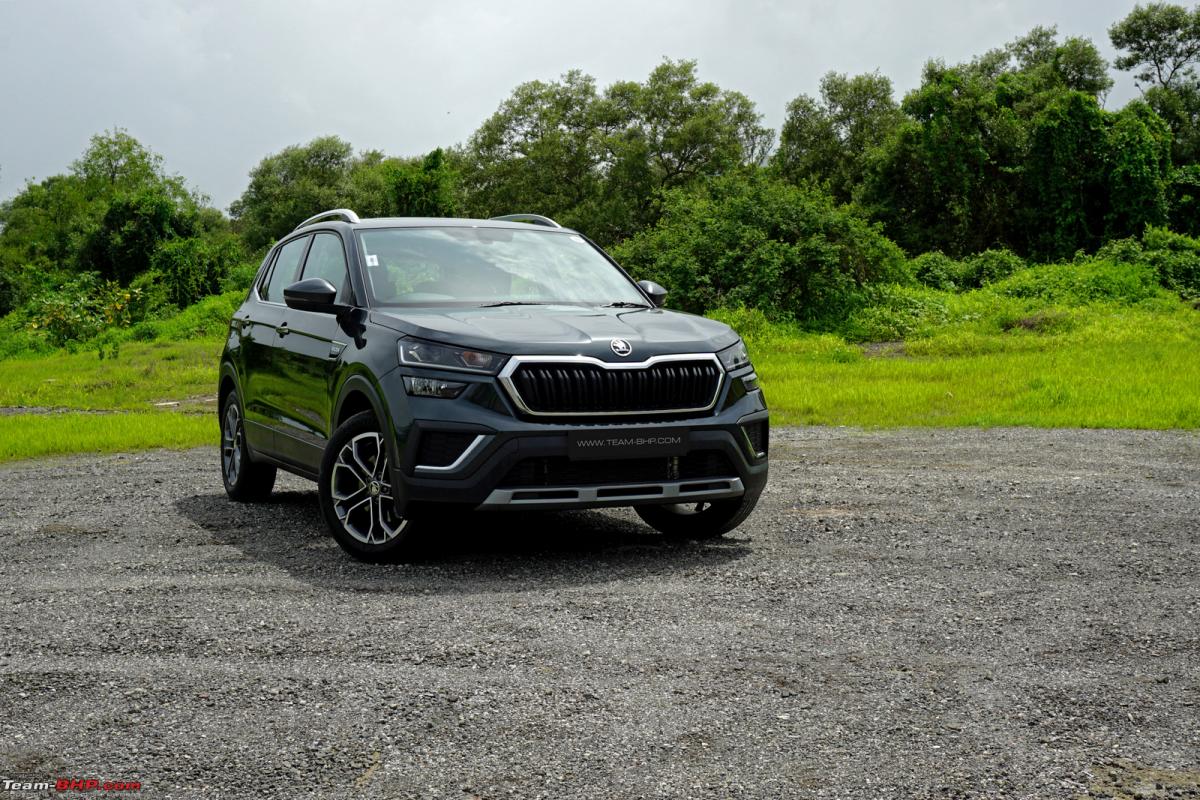
What you'll like:
- A breath of fresh (European) air in a sea of Korean, Chinese & Indian SUVs
- Classy exterior & interior styling matched with solid European build quality
- Cabin has good legroom to offer, supportive seats, perfect ergonomics & lots of storage
- 148 BHP engine makes the Kushaq one of the most fun-to-drive crossovers in the segment
- Sporty 1.0L & 1.5L turbo-petrols are mated to slick 6-speed MTs & smooth ATs
- Sorted suspension offers a balanced ride & handling package
- Safety features include 6 airbags (sadly MT only), ESC (all variants), 3-point seatbelts for all, electronic differential lock, brake disc wiping, multi-collision brake and more
- 6-year extended warranty & 4-year all inclusive service packages available
- Features like active cylinder tech, ventilated seats, sunroof, wireless Android Auto and CarPlay, audio system with a punchy subwoofer, auto headlamps & wipers etc.
- 5-star GNCAP safety rating - full details here!
What you won't:
- No 1.5L diesel is a major disadvantage in a world where petrol costs over 100 bucks / litre
- DQ200 DSG transmission has a history of poor reliability & breakdowns in India
- Narrow width makes a 5th adult completely unwelcome. Best for 4 onboard
- Lovely 1.5L TSI is only available on the top variant
- At 385 litres, boot space is lesser than its direct rivals (Creta & Seltos = 433L)
- Sure lacks the street cred / presence offered by some competitors
- Skoda’s notorious dealerships & after-sales horror stories
- Missing some now expected features such as driving modes (sport), panoramic sunroof, 360-degree camera, electric driver's seat adjustment & regular USB ports
- Turbo-petrols are very sensitive to driving style. FE will drop drastically when you drive hard
Jeep Compass
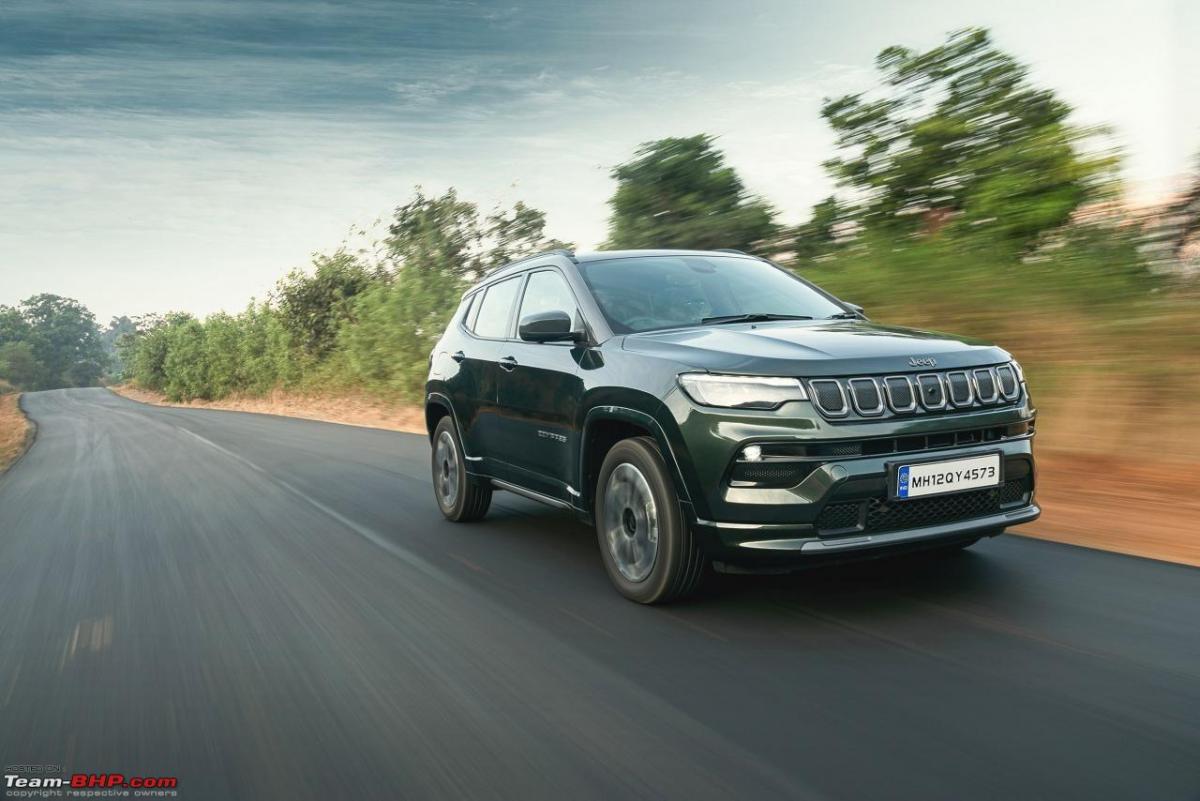
What you'll like:
- Handsome Cherokee-inspired styling & loads of character
- Solid build. Feels very robust, just as a Jeep should
- Powerful 2.0L diesel. Good driveability in the city, fast on the open road
- 1.4L turbo-petrol makes 161 BHP! Offers fast performance.
- Mature suspension setup, nicely-tuned EPS & rock-solid stability
- Capable AWD available (unlike some competitors)
- City-friendly: Compact size, higher seating, smooth gearshift, soft clutch & low NVH
- Topnotch safety: Strong all-disc brakes, a plethora of electronic aids & 6 airbags
- We think the Compass is well-priced for what it offers. The driving experience & overall package feel premium
What you won't:
- Small size for the price! A sentiment echoed by most people who saw it in person
- Suitable for 4 adults, not 5. Boot is small too
- Tiny dealership network. Plus, after-sales quality & long-term reliability are unknown factors
- 4x4 is no longer available with the MT. AWD AT commands a ~4 lakh premium over 4x2 MT
- Turning radius of 5.65m is wide. Also, 17º approach angle is too low
- Missing goodies (blanks on the steering, lumbar adjustment, reclinable rear seats)
Link to Report - The Trailhawk
Mahindra XUV 700

What you'll like:
- Handsome styling matched to solid build quality. Has street presence, feels robust
- Very spacious interiors with comfy seats and sorted ergonomics. 6-footer passengers welcome!
- 182 BHP turbo-diesel & 197 BHP turbo-petrol make for a potent line-up
- Smooth 6-speed torque converter Automatics available with both engines
- Sorted suspension with good road manners & high speed stability
- AWD available for the adventurous, unlike most FWD crossovers in the segment
- Loaded with features like radar-based driver assistance system, pop-out door handles, panoramic sunroof, driver memory seat, 360-degree camera, 10.25" infotainment & instrument cluster etc.
- 12-speaker Sony audio system is fantastic! You'll enjoy its sound quality
- Safety features include 7 airbags, ESP, all-wheel disc brakes, hill hold, hill descent control, driver drowsiness detection, TPMS, ISOFIX...
What you won't:
- Negligible boot space with the 3rd-row seat up. Either 5 onboard, or 7 with a roof-top carrier
- Cramped 3rd-row seat is best suited to children only. A sliding middle row is sorely missed
- Petrol AT is thirsty due to its hefty weight, 197 BHP & torque-converter AT
- Some cabin plastics & a few rough areas don't feel premium in an otherwise loaded SUV
- Missing features such as an auto-dimming IRVM, ventilated seats, paddle shifters, full-size spare wheel, ambient lighting, rear sunblinds...
- Concerns over niggles & bugs in a freshly baked, complex Mahindra. We saw 2!
- Mahindra's after-sales service is a hit or miss. Remains a gamble
- AWD is available just with the Diesel AT, and not the MT or petrol motor
Here's what GTO had to say on the matter:
Enthusiasts can blast the Hector all they want, but the fact is, it is unbeatable as a spacious, comfortable, family cruiser with a softly sprung suspension. I have recommended the Hector to many people in my circle who were looking purely at a comfort-mobile and each of them is very happy with the purchase. MG also scores well on sales & service experiences.
It is however, not my kind of car. If I were buying an SUV in this segment, it would be the XUV700. If high running, then the practical Diesel AT. If the usage is on the lower side, then the fast & refined Petrol AT.
Here's what BHPian AtheK had to say on the matter:
Great comparison, and I eventually settled for facelift Hector. The enthusiast in me has taken a back seat as years have gone by, and my prime requirement in the car was for my 9 year old son to be comfortable on long drives. Secondary was to have a very good music system that I can listen to, when I put the car on cruise control at 110 on highway and have a good relaxed drive. Hector is slow of the block but once turbo kicks in it cruises silently at 110 with enough power on tap to make some quick overtakes. Hector checked both my requirements and wife loved the view and space in passenger seat as well. The worldly creatures like ventilated seats, ambient lights, electrnic boot and wireless CarPlay adds up to overall mood uplift. We took the car for a long 100 KM drive to see if my son was comfortable and he really had a good time in the car which sealed it. Need to zero down on the bling though as I personally don't like chrome at all, so a lot of that will be taken out.
For the enthusiast in me I have my bikes, I can have all the fun I want and no one to bother me every second to slow down.
All in all I echo GTO sentiment and he has put it perfectly this car is not for enthusiasts they need to look at XUV. I had also given XUV a long thought but 9-10 months of waiting was something I was not ready for and also deal with the niggles in the car, they still have issues with wireless android auto and CarPlay.
PS: One car which can now make entry to this list is Alcazar, now with a new turbo engine which puts in a very good power it can actually be a great choice. As a matter of fact I was thinking of going to take a test drive if new engine but got a message that my hector has been allocated so now will take delivery of hector next week.
Read BHPian comments for more insights and information.
News
Skoda Kushaq owner surprised by Tata Harrier's good fuel efficiency
I comfortably managed to do 1000 km in a tank full. Using the same driving pattern, I get a 900-950 kms range in my Kushaq.
BHPian ashutoshb recently shared this with other enthusiasts.
My late father's Harrier (2019, Manual) just crossed 50,000 kms. With no major issues faced till now, we have been more than satisfied with it.
Ever since my father passed away, during the second wave of Covid, his Harrier has largely been unused. My mother uses it rarely, once or twice a month, to visit relatives. The driver does start it for a couple of minutes every week.
For her nearby runs, our humble Nano AMT is my mom's preferred car, which is easier to park and drive around on Noida streets.
My daily run is around 70 kms, Greater Noida <> Noida. Since my Kushaq (1.0 AT) had been munching miles at a very fast pace, I decided to give it a rest and use the Harrier for a while. I drove it for around 1500 kms, for my daily commute, which is 60% expressway and 40% in the city. And surprisingly, I got a pretty good fuel efficiency.
In a tank full, I managed to do 1000 KMs, comfortably. By comfortably, I mean, never did I use the Eco mode. I did use sport mode several times. What was constant, the cruising speed was 80-90 on the expressway and I changed gears around 1500-1700 rpm, always. And I always drove sedately when the engine was cold.
Using the same driving pattern, I consistently get a 900-950 kms range in my Kushaq.
In all, I am really pleased with the Harrier, but since it's a manual, I will now go back to my Kushaq.
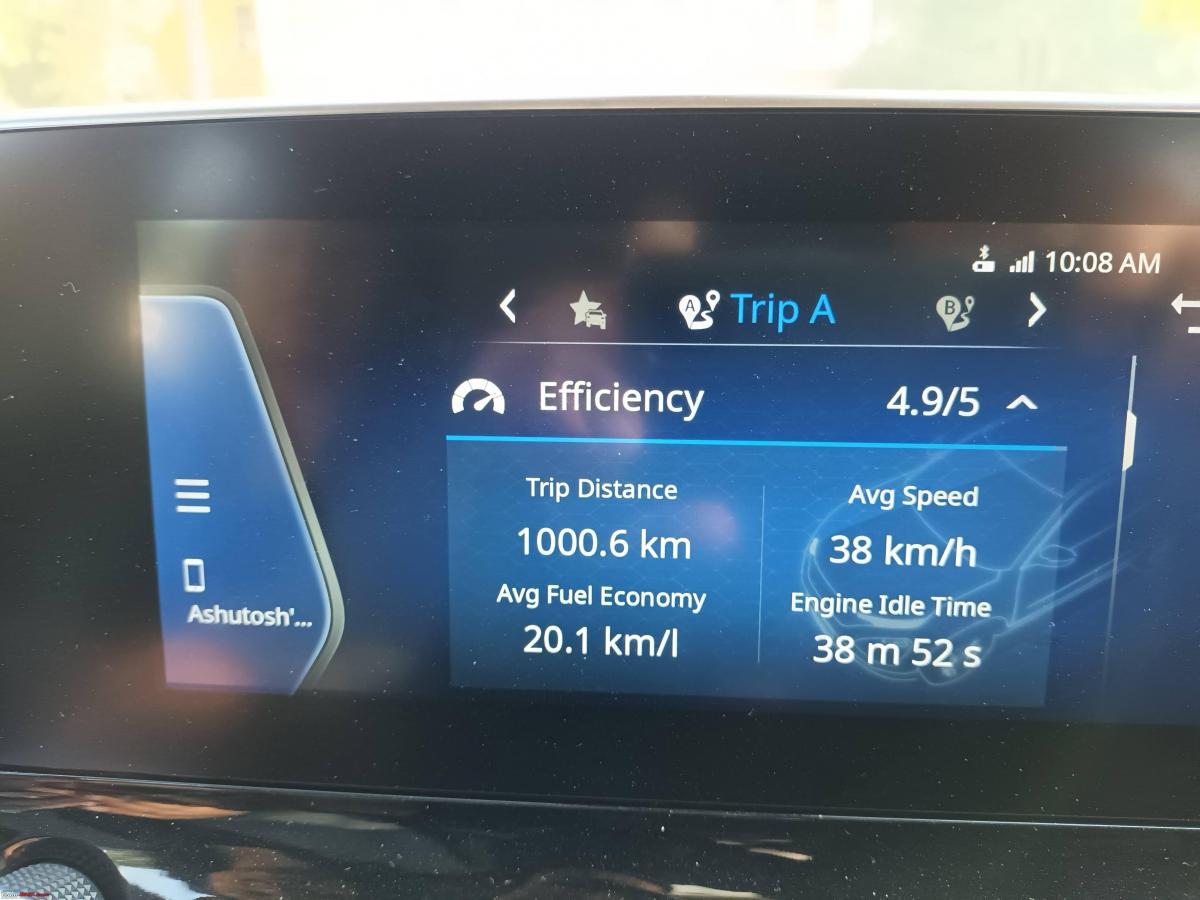

Check out BHPian comments for more insights and information.
Pages





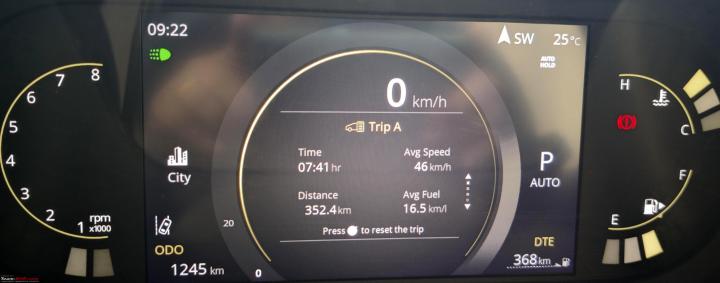
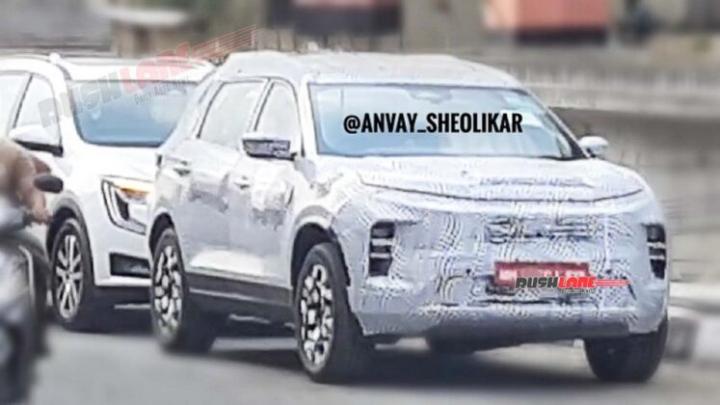

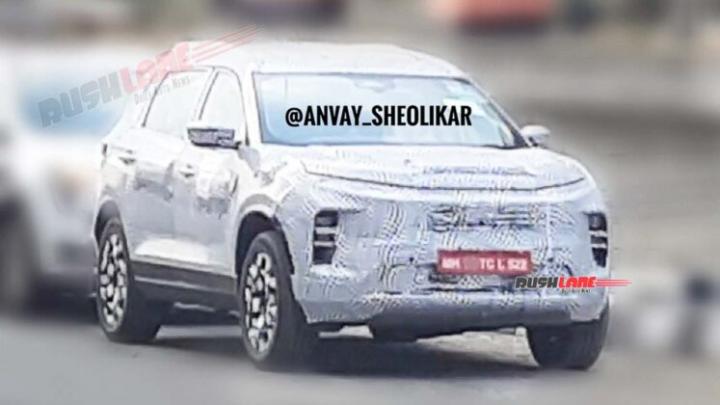
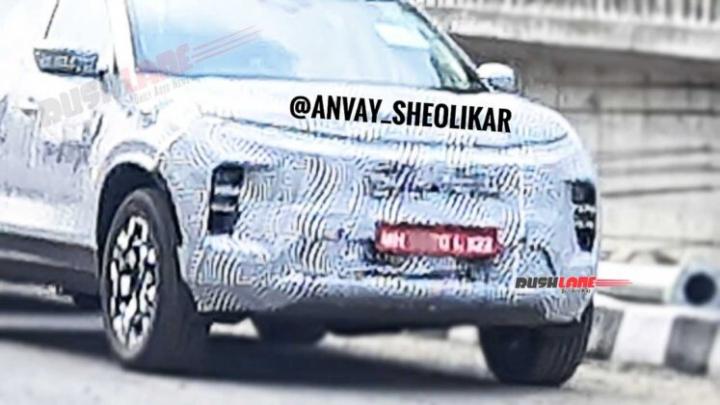





.jpeg)
















